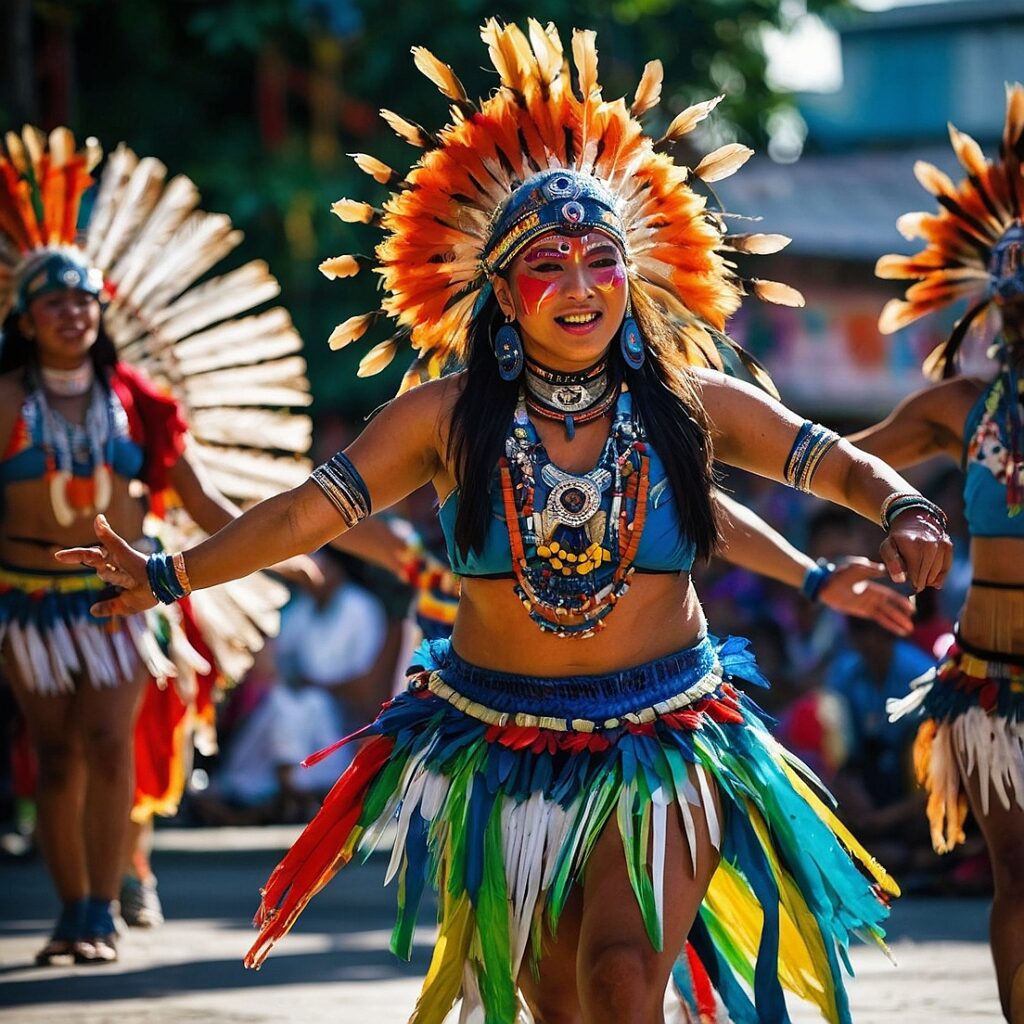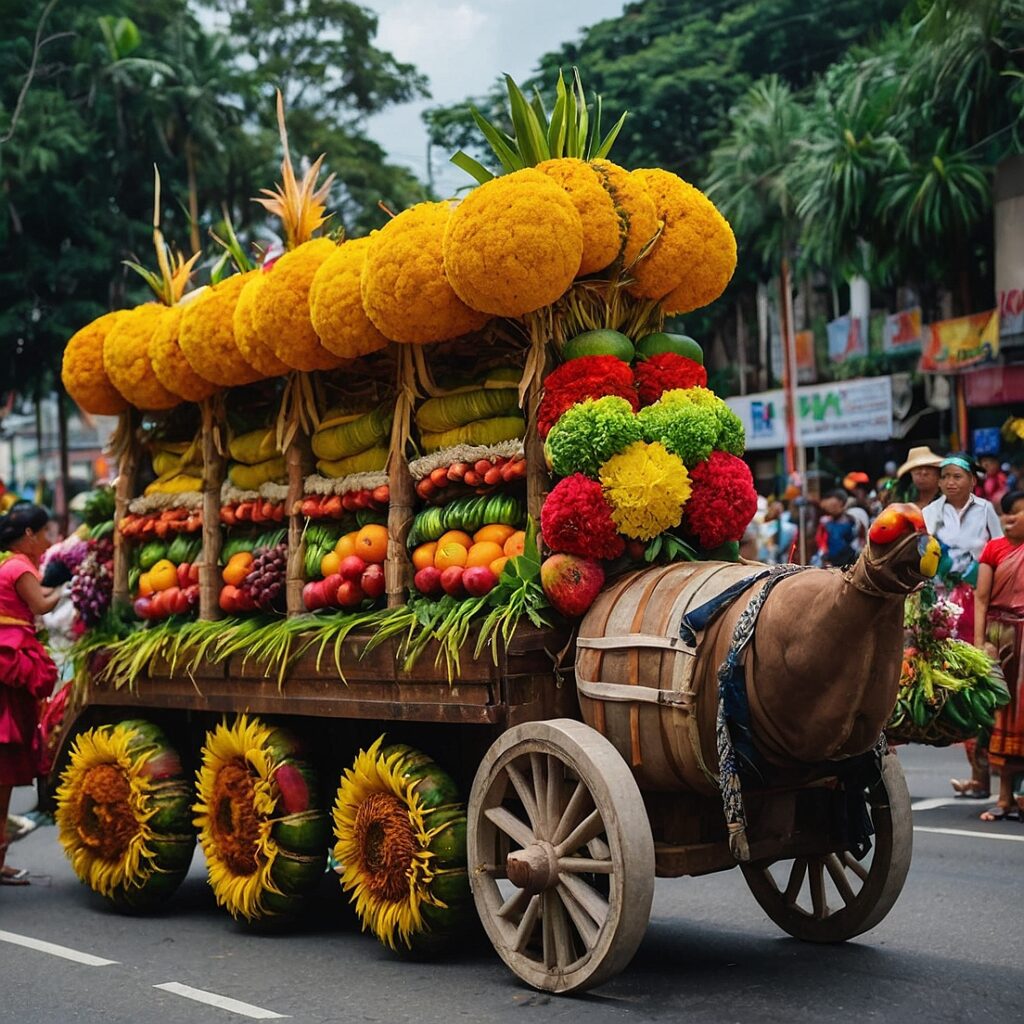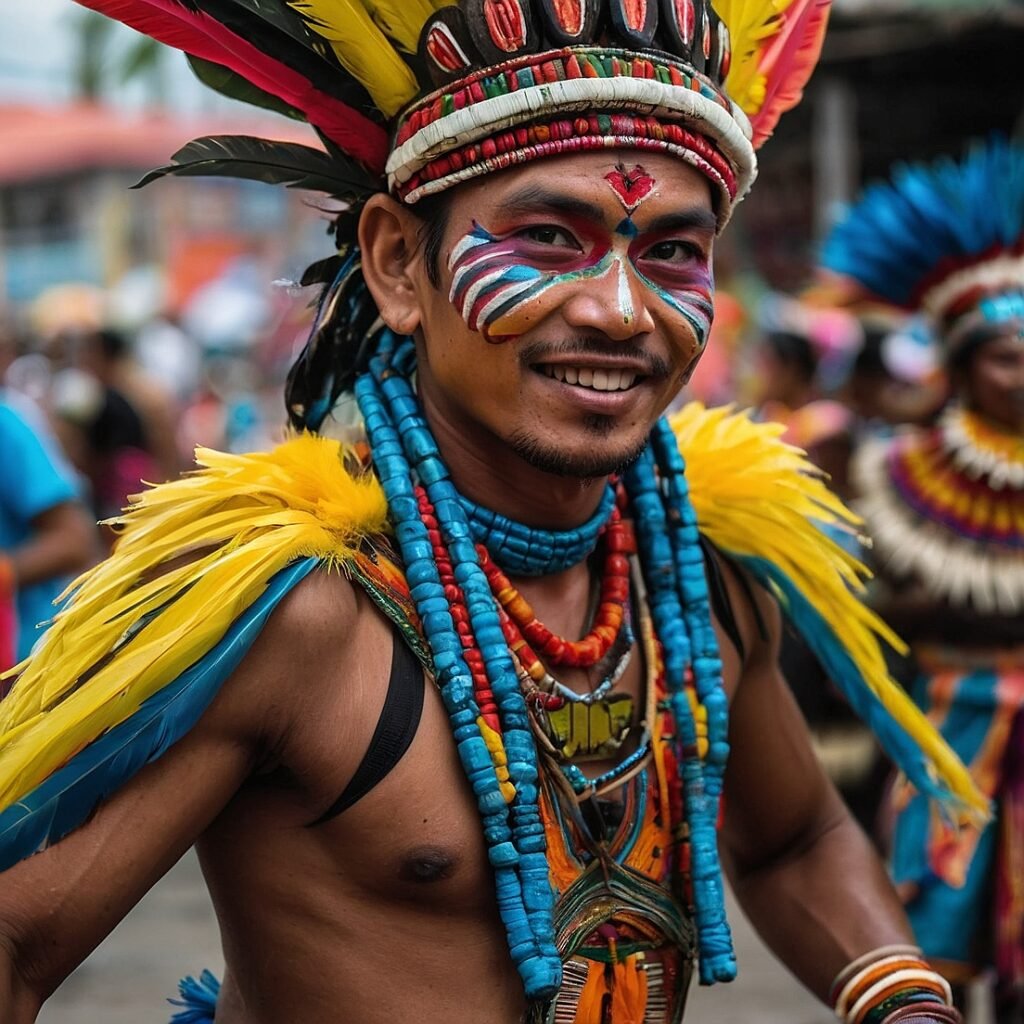Welcome to the vibrant world of Ati-Atihan, one of the Philippines’ most exhilarating and culturally rich festivals! If you’re looking for an explosion of colors, rhythms, and Filipino hospitality, you’ve come to the right place. Held annually in Kalibo, Aklan, this festival is not just a feast for the eyes but a journey through history, faith, and pure, unadulterated fun. In this blog, we’ll dive deep into the heart of Ati-Atihan, exploring its origins, traditions, and why it should be on every traveler’s bucket list. So, grab your imaginary tribal paint and let’s embark on this wild ride through one of the Philippines’ most beloved celebrations!
The Roots of Ati-Atihan: A Tale of Two Cultures
A Journey Back in Time
To truly appreciate Ati-Atihan, we need to take a step back in time. Picture this: it’s the 13th century, and a group of Malay chieftains from Borneo have just arrived on the shores of Panay Island. They’re greeted by the indigenous Ati people, known for their dark skin and curly hair. This encounter wasn’t just a footnote in history; it was the seed from which Ati-Atihan would grow.
The story goes that the Malay settlers, led by Datu Puti, sought to purchase land from the Atis. In a gesture of goodwill and celebration, the Malays darkened their skin with soot to resemble their Ati hosts. This act of cultural appreciation and unity is what we now celebrate as Ati-Atihan, which literally means “to be like Atis.”
From Pagan Roots to Christian Celebration
Over the centuries, Ati-Atihan evolved. With the arrival of Spanish colonizers and Christianity in the 16th century, the festival took on religious significance. It became associated with the Santo Niño (Child Jesus), blending indigenous traditions with Catholic devotion. This fusion created a unique celebration that reflects the Philippines’ complex cultural tapestry.
Today, Ati-Atihan is a vibrant mix of tribal dances, colorful costumes, pulsating music, and religious processions. It’s a testament to the Filipino spirit of adaptability and joy, where ancient customs dance hand in hand with modern revelry.
The Festival Experience: A Sensory Overload
Sights, Sounds, and Spectacles
Imagine streets filled with people painted in dark makeup, adorned with feathers, shells, and vibrant fabrics. The air is thick with the sound of drums and the chants of “Hala Bira! Pwera Pasma!” (Keep going! Ward off illness!). This is Ati-Atihan in full swing, and it’s a sensory experience like no other.
The festival typically spans several days, culminating in a grand parade on the third Sunday of January. Each day brings its own flavor of celebration, from street dancing competitions to beauty pageants and fireworks displays. But the heart of Ati-Atihan lies in its spontaneity – anyone can join the street dancing, paint their faces, and become part of this living, breathing carnival.
The Rhythm of Ati-Atihan
Music is the lifeblood of Ati-Atihan. The distinctive beat of the drums, known as the “Ati-Atihan rhythm,” is infectious. It’s not uncommon to see people dancing in the streets, moving to the primal beats that seem to awaken something ancient within us all. The music isn’t just entertainment; it’s a call to join in, to let go of inhibitions and become one with the festival spirit.
Beyond the Party: The Cultural Significance
A Celebration of Identity
While Ati-Atihan is undoubtedly a grand party, it’s also deeply rooted in cultural identity. For the people of Kalibo and the wider Aklan province, this festival is a proud display of their heritage. It’s a time when the community comes together, reinforcing social bonds and passing down traditions to younger generations.
The festival serves as a living museum of sorts, preserving dances, music, and customs that might otherwise be lost to time. It’s a reminder of the Philippines’ rich pre-colonial history and the diversity that makes up the nation’s cultural fabric.
Faith and Festivity
At its core, Ati-Atihan is also a religious festival. The devotion to the Santo Niño is palpable, with many participants joining not just for the party but as an act of faith. The religious aspects of the festival include novena masses, processions, and the blessing of the Santo Niño images.
This blend of the sacred and the secular is quintessentially Filipino. It’s a reflection of how Christianity has been adapted and integrated into local culture, creating a unique form of devotion that’s both deeply spiritual and joyously celebratory.
Preparing for Ati-Atihan: Tips for Travelers
When to Go and What to Expect
If you’re planning to experience Ati-Atihan firsthand, timing is everything. The festival typically takes place in the third week of January, with the main events happening from Friday to Sunday. However, the exact dates can vary, so it’s always best to check the official schedule before booking your trip.
Here’s a quick guide to help you prepare:
| Aspect | Details |
|---|---|
| Best time to visit | Third week of January |
| Duration | 1 week (main events over the weekend) |
| Weather | Generally dry and cool (average temp: 25°C/77°F) |
| What to wear | Light, comfortable clothing; prepare to get messy! |
| What to bring | Camera, water bottle, comfortable shoes |
| Accommodation | Book early, as hotels fill up quickly |
Embracing the Spirit of Ati-Atihan
To truly enjoy Ati-Atihan, come with an open mind and a willingness to participate. Don’t be shy about joining in the street dancing or getting your face painted. The more you immerse yourself, the more memorable your experience will be.
Remember, Ati-Atihan is about community and inclusivity. Whether you’re a local or a foreigner, you’ll be welcomed with open arms. It’s this spirit of hospitality that makes the festival truly special.
The Impact of Ati-Atihan: Beyond the Festival Grounds
Economic Boost for Kalibo
Ati-Atihan isn’t just a cultural phenomenon; it’s a significant economic driver for Kalibo and the surrounding areas. Each year, the festival attracts thousands of visitors, both domestic and international, providing a substantial boost to the local economy.
Hotels, restaurants, transportation services, and local artisans all benefit from the influx of tourists. The festival has become a crucial part of Kalibo’s tourism strategy, helping to put this charming town on the global map.
Preserving Heritage in a Changing World
In an era of rapid globalization, festivals like Ati-Atihan play a crucial role in preserving cultural heritage. They serve as a bridge between the past and the present, allowing younger generations to connect with their roots in a tangible, exciting way.
The festival has evolved over time, incorporating modern elements while staying true to its core traditions. This balance of old and new ensures that Ati-Atihan remains relevant and vibrant, even as the world around it changes.
The Future of Ati-Atihan: Challenges and Opportunities
Sustainability Concerns
As Ati-Atihan grows in popularity, it faces challenges common to many large-scale festivals. Environmental concerns, such as waste management and the impact of large crowds on local infrastructure, are becoming increasingly important.
Festival organizers and local authorities are working to implement more sustainable practices, such as promoting the use of eco-friendly materials and improving waste management systems. These efforts are crucial for ensuring that Ati-Atihan can continue to thrive without compromising the beautiful environment of Kalibo.
Balancing Tradition and Tourism
Another challenge is maintaining the authenticity of the festival while catering to a growing tourist audience. There’s a delicate balance between preserving the cultural integrity of Ati-Atihan and making it accessible and appealing to visitors from around the world.
Efforts are being made to educate visitors about the festival’s history and significance, encouraging respectful participation that honors the traditions of Ati-Atihan. This approach aims to create a more meaningful experience for tourists while preserving the festival’s cultural essence.
Beyond Ati-Atihan: Exploring Kalibo and Aklan
Discovering Kalibo’s Charms
While Ati-Atihan is undoubtedly the star attraction, Kalibo and the wider Aklan province have much more to offer. Visitors who extend their stay can explore a range of cultural and natural attractions.
Some must-visit spots include:
- Bakhawan Eco-Park: A stunning mangrove forest that showcases Kalibo’s commitment to environmental conservation.
- Museo it Akean: A local museum that offers deeper insights into the region’s history and culture.
- Kalibo Cathedral: A beautiful church that plays a central role in the Ati-Atihan celebrations.
Aklan’s Natural Wonders
Venture beyond Kalibo, and you’ll find that Aklan province is a treasure trove of natural beauty. From pristine beaches to lush forests, there’s no shortage of stunning landscapes to explore.
Of course, no mention of Aklan would be complete without talking about Boracay. This world-famous island paradise is just a short trip from Kalibo, offering the perfect beach getaway after the excitement of Ati-Atihan.
The Global Impact: Ati-Atihan Around the World
Spreading Filipino Culture
The influence of Ati-Atihan extends far beyond the shores of the Philippines. Filipino communities around the world have embraced the festival, organizing their own versions in cities from New York to Dubai. These international celebrations serve as a way for overseas Filipinos to connect with their heritage and share their culture with their adopted homes.
These global Ati-Atihan events may not match the scale of the original in Kalibo, but they capture its spirit of joy, community, and cultural pride. They’ve become important cultural events in their own right, promoting Filipino culture on the world stage.
Cultural Exchange and Tourism
The international reach of Ati-Atihan has also contributed to increased cultural exchange and tourism. Many who experience these international versions of the festival are inspired to visit the Philippines and experience the real thing in Kalibo.
This global interest has led to collaborations between Kalibo and international cities, fostering cultural exchanges that go beyond just the festival. It’s a testament to how a local tradition can become a bridge between cultures, promoting understanding and appreciation on a global scale.
Ati-Atihan in the Digital Age: Keeping Traditions Alive
Embracing Social Media
In recent years, Ati-Atihan has embraced the digital age, using social media and online platforms to reach a wider audience. Instagram-worthy moments from the festival flood social media feeds, giving the world a glimpse of the vibrant celebration and inspiring wanderlust in potential visitors.
Festival organizers have also leveraged digital platforms for event promotion, real-time updates, and even virtual experiences for those who can’t attend in person. This digital presence has been crucial in keeping the festival relevant to younger generations and expanding its global reach.
Virtual Ati-Atihan Experiences
The COVID-19 pandemic presented unique challenges for festivals worldwide, and Ati-Atihan was no exception. However, the spirit of the festival proved resilient. Virtual celebrations were organized, allowing people from around the world to participate in online dance competitions, watch live-streamed performances, and learn about the festival’s history through digital exhibits.
While these virtual experiences can’t fully replicate the energy of being there in person, they’ve opened up new possibilities for participation and engagement. Even as we return to in-person celebrations, these digital elements are likely to remain, creating a hybrid festival experience that combines the best of both worlds.
The Enduring Magic of Ati-Atihan
As we wrap up our journey through the wild and wonderful world of Ati-Atihan, it’s clear that this festival is more than just a annual event – it’s a living, breathing embodiment of Filipino culture, history, and spirit. From its ancient roots to its modern-day global influence, Ati-Atihan continues to captivate and inspire.
Whether you’re dancing in the streets of Kalibo, painted head to toe in tribal designs, or experiencing the festival through a screen thousands of miles away, Ati-Atihan has a way of touching your soul. It reminds us of the power of community, the importance of preserving cultural heritage, and the sheer joy that comes from celebrating life in all its colorful glory.
So, as the drums of Ati-Atihan continue to beat, echoing through time and across oceans, we’re left with an invitation – to join in, to lose ourselves in the rhythm, and to become part of this incredible story. After all, in the spirit of Ati-Atihan, we’re all part of one global community, united in our love for culture, celebration, and the enduring human spirit.
Whether you’re planning your next adventure or simply dreaming of far-off festivals, let the spirit of Ati-Atihan inspire you. Who knows? Maybe next January, you’ll find yourself in Kalibo, paint on your face, moving to the beat of the drums, and experiencing firsthand the magic that is Ati-Atihan. Until then, “Hala Bira! Pwera Pasma!” – may the spirit of the festival be with you, wherever you are.
Disclaimer: This blog post is based on information available up to 2020. While we strive for accuracy, some details may have changed since then. We encourage readers to check official sources for the most up-to-date information on the Ati-Atihan festival. If you notice any inaccuracies, please report them so we can correct them promptly.




